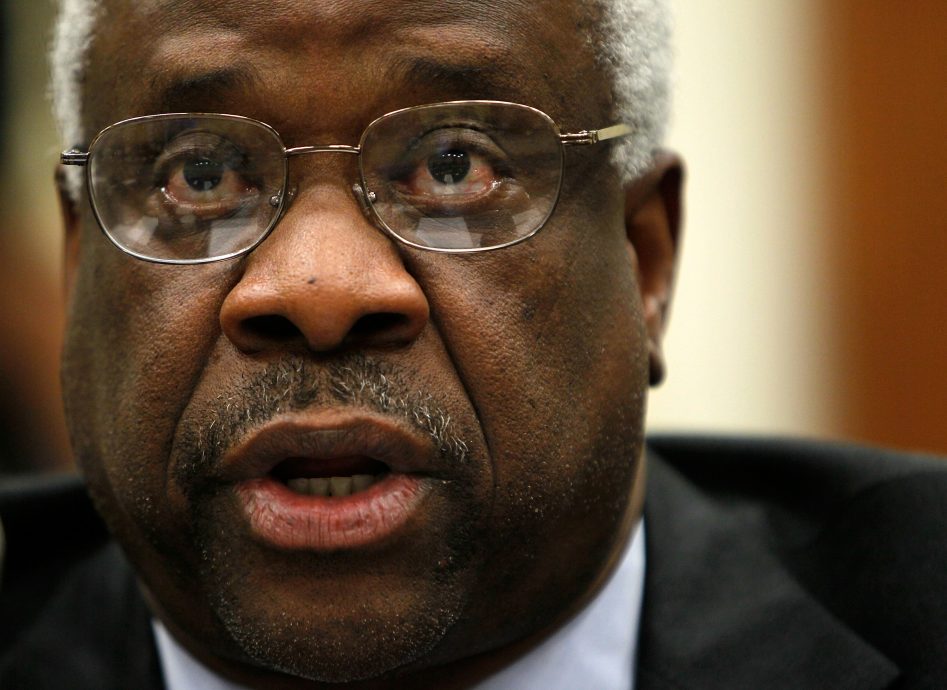The Court's Last Shreds of Legitimacy
Justice Clarence Thomas has written two significant opinions concerning abortion. Seventeen years ago in his lengthy dissent in Stenberg v. Carhart (2000), he denied that there is a constitutional right to abortion; he called Roe v. Wade (1973) “grievously wrong” and insisted that nothing in the Constitution “deprives the people of this country of the right to determine whether the consequences of abortion to the fetus and to society outweigh the burden of an unwanted pregnancy on the mother.” After declaring that the “undue burden” standard announced in Planned Parenthood v. Casey (1992) was created “out of whole cloth” and devoid of any “historical or doctrinal pedigree,” he then described in horrific detail what occurs during a partial-birth abortion.
His second significant opinion was delivered last week; however; his dissent in Whole Woman’s Health v. Hellerstedt was not about whether there is a constitutional right to abortion but rather about how “the Court’s habit of applying different rules to different constitutional rights—especially the putative right to abortion”—is destroying the principle of the rule of law.
Thomas’s dissent is a lament to the failed “promise of a judiciary bound by the rule of law.” It concludes with these words: “The majority’s embrace of a jurisprudence of rights-specific exceptions and balancing tests is ‘a regrettable concession of defeat—an acknowledgement that we have passed the point where law, properly speaking, has any further application.’ Scalia, The Rule of Law as a Law of Rules, 56 U. Chi. L. Rev. 1175, 1182 (1989). I respectfully dissent.”
Just as Thomas concludes his opinion by quoting the late Justice Antonin Scalia, so he begins it. Justice Breyer’s majority opinion, he writes, “exemplifies the Court’s troubling tendency ‘to bend the rules when any effort to limit abortion, or even to speak in opposition to abortion, is at issue.” Stenberg v. Carhart (2000) (Scalia, J., dissenting).” In fact, Thomas quotes Scalia seven times in his dissent, and there is a reason. In United States v. Virginia (1996), Scalia attacked the Court’s use of intermediate scrutiny, declaring that it applies it “when it seems like a good idea to load the dice.” Thomas’s entire dissent builds on Scalia’s critique and the devastating consequences for the rule of law that flow from it. “[T]he label the Court affixes to its level of scrutiny in assessing whether the government can restrict a given right—be it ‘rational basis,’ intermediate, strict, or something else—is increasingly a meaningless formalism. As the Court applies whatever standard it likes to any given case, nothing but empty words separates our constitutional decisions from judicial fiat.”
Thomas pointed out that ‘[t]hough the tiers of scrutiny have become a ubiquitous feature of constitutional law, they are of recent vintage. Only in the 1960s did the Court begin in earnest to speak of ‘strict scrutiny’ versus reviewing legislation for mere rationality, and to develop the contours of these tests.” Over time, “the tiers of scrutiny proliferated into ever more gradations,” with Craig v. Boren (1976) adding intermediate scrutiny for sex-based classifications and with Casey adding the undue-burden test, “ yet another right-specific test on the spectrum between rational-basis and strict-scrutiny review.” Yet, the use of these “made-up tests” to “displace longstanding national traditions as the primary determinant of what the Constitution means (United States v. Virginia, Scalia, J., dissenting)” is, for Thomas, simply “illegitimate.” “The Constitution does not prescribe tiers of scrutiny. The three basic tiers—‘rational basis,’ intermediate, and strict scrutiny—‘are no more scientific than their names suggest, and a further element of randomness is added by the fact that it is largely up to us which test will be applied in each case.’”
But, according to Thomas, the problem goes well “beyond that,” as “our recent cases illustrate . . . how easily the Court tinkers with levels of scrutiny to achieve its desired result.” He pointed out that “[t]his Term, it is easier for a State to survive strict scrutiny despite discriminating on the basis of race in college admissions [Fisher v. University of Tex. at Austin] than it is for the same State to regulate how abortion doctors and clinics operate under the putatively less stringent undue-burden test.” And, looking at the recent terms of the Court, he observed that “it is now easier for the government to restrict judicial candidates’ campaign speech [Williams-Yulee v. Florida Bar (2015)] than for the Government to define marriage [United States v. Windsor (2013)]—even though the former is subject to strict scrutiny and the latter was supposedly subject to some form of rational-basis review.”
Thomas argued that these decisions “reflect the Court’s tendency to relax purportedly higher standards of review for less-preferred rights” such as the core free speech right to make political contributions, while selectively applying rational-basis review—under which the question is supposed to be whether ‘any state of facts reasonably may be conceived to justify’ the law—with formidable toughness” when it comes to same-sex marriage. As Thomas remarked: “These labels now mean little. Whatever the Court claims to be doing, in practice it is treating its ‘doctrine referring to tiers of scrutiny as guidelines informing our approach to the case at hand, not tests to be mechanically applied.’ The Court should abandon the pretense that anything other than policy preferences underlies its balancing of constitutional rights and interests in any given case.”
All the evidence Thomas adduces led him to fear for the future of the rule of law. “The Court has simultaneously transformed judicially created rights like the right to abortion into preferred constitutional rights, while disfavoring many of the rights actually enumerated in the Constitution. But our Constitution renounces the notion that some constitutional rights are more equal than others. . . . Unless the Court abides by one set of rules to adjudicate constitutional rights, it will continue reducing constitutional law to policy-driven value judgments until the last shreds of its legitimacy disappear.”



